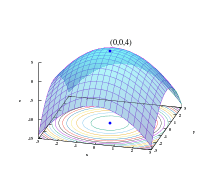Penalty method
Penalty methods are a certain class of algorithms for solving constrained optimization problems.
A penalty method replaces a constrained optimization problem by a series of unconstrained problems whose solutions ideally converge to the solution of the original constrained problem. The unconstrained problems are formed by adding a term, called a penalty function, to the objective function that consists of a penalty parameter multiplied by a measure of violation of the constraints. The measure of violation is nonzero when the constraints are violated and is zero in the region where constraints are not violated.
Example
Let us say we are solving the following constrained problem:
subject to
This problem can be solved as a series of unconstrained minimization problems
where
In the above equations, is the penalty function while are the penalty coefficients. In each iteration k of the method, we increase the penalty coefficient (e.g. by a factor of 10), solve the unconstrained problem and use the solution as the initial guess for the next iteration. Solutions of the successive unconstrained problems will eventually converge to the solution of the original constrained problem.
Practical application
Image compression optimization algorithms can make use of penalty functions for selecting how best to compress zones of colour to single representative values.[1][2]
Barrier methods
Barrier methods constitute an alternative class of algorithms for constrained optimization. These methods also add a penalty-like term to the objective function, but in this case the iterates are forced to remain interior to the feasible domain and the barrier is in place to bias the iterates to remain away from the boundary of the feasible region.
See also
References
- ↑ Galar, M.; Jurio, A.; Lopez-Molina, C.; Paternain, D.; Sanz, J.; Bustince, H. (2013). "Aggregation functions to combine RGB color channels in stereo matching". Optics Express. 21: 1247–1257. doi:10.1364/oe.21.001247.
- ↑ "Researchers restore image using version containing between 1 and 10 percent of information". Phys.org (Omicron Technology Limited). Retrieved 26 October 2013.
Smith, Alice E.; Coit David W. Penalty functions Handbook of Evolutionary Computation, Section C 5.2. Oxford University Press and Institute of Physics Publishing, 1996.
Courant, R. Variational methods for the solution of problems of equilibrium and vibrations. Bull. Amer. Math. Soc., 49, 1–23, 1943.
